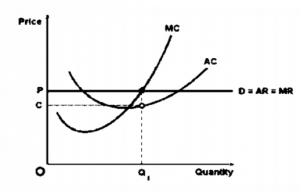Use diagrams as appropriate.
Under perfect competition, there are many buyers and sellers in the industry. The firms are price takers and cannot influence price, as such they must always compete at their maximum level of efficiency. There are no barriers to entry. Firms attempt to maximize profits. In the short run, if firms are making a supernormal profit, new firms enter the market place and reduce profit as a result of increasing supply and driving the price downwards to a position where all firms in the industry will only make a normal profit, thereby enabling firms only earn normal profit in the long run. If firms are making a loss they exit the industry. Firms are therefore typically maximizing the utilization of resources and producing at all times at the minimum cost–point.
In the short-run, it is possible for an individual firm to make a profit. This situation is shown in this diagram, as the price or average revenue, denoted by P, is above the average cost denoted by C.

However, in the long period, positive profit cannot be sustained. The arrival of new firms or expansion of existing firms (if returns to scale are constant) in the market causes the (horizontal) demand curve of each individual firm to shift downward, bringing down at the same time the price, the average revenue and marginal revenue curve. The final outcome is that, in the long run, the firm will make only normal profit (zero economic profit). Its horizontal demand curve will touch its average total cost curve at its lowest point.
